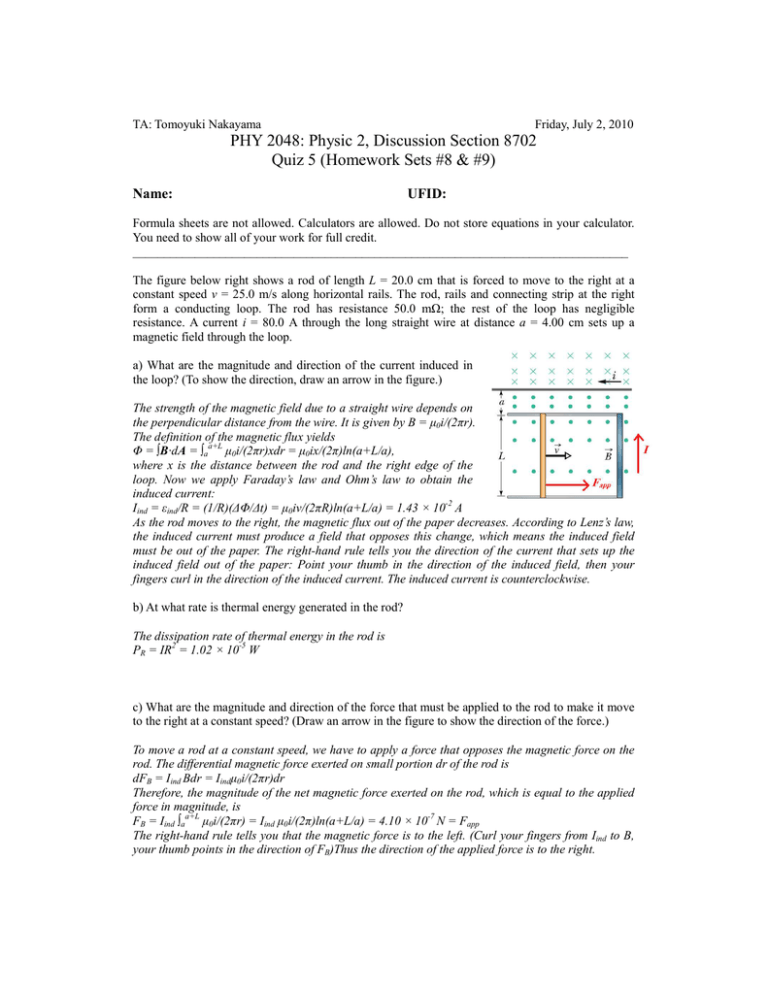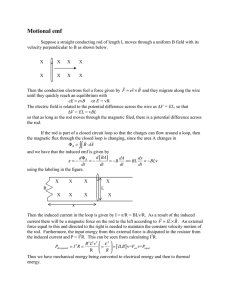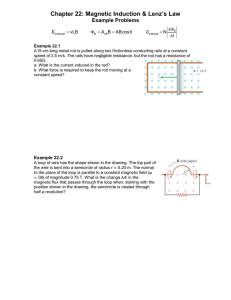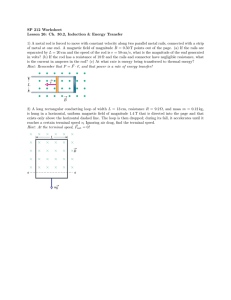PHY 2048: Physic 2, Discussion Section 8702 Quiz 5 (Homework
advertisement

TA: Tomoyuki Nakayama Friday, July 2, 2010 PHY 2048: Physic 2, Discussion Section 8702 Quiz 5 (Homework Sets #8 & #9) Name: UFID: Formula sheets are not allowed. Calculators are allowed. Do not store equations in your calculator. You need to show all of your work for full credit. ________________________________________________________________________________ The figure below right shows a rod of length L = 20.0 cm that is forced to move to the right at a constant speed v = 25.0 m/s along horizontal rails. The rod, rails and connecting strip at the right form a conducting loop. The rod has resistance 50.0 mΩ; the rest of the loop has negligible resistance. A current i = 80.0 A through the long straight wire at distance a = 4.00 cm sets up a magnetic field through the loop. a) What are the magnitude and direction of the current induced in the loop? (To show the direction, draw an arrow in the figure.) The strength of the magnetic field due to a straight wire depends on the perpendicular distance from the wire. It is given by B = µ0i/(2πr). The definition of the magnetic flux yields Φ = ∫B·dA = ∫aa+L µ0i/(2πr)xdr = µ0ix/(2π)ln(a+L/a), where x is the distance between the rod and the right edge of the loop. Now we apply Faraday’s law and Ohm’s law to obtain the induced current: Iind = εind/R = (1/R)(∆Φ/∆t) = µ0iv/(2πR)ln(a+L/a) = 1.43 × 10-2 A As the rod moves to the right, the magnetic flux out of the paper decreases. According to Lenz’s law, the induced current must produce a field that opposes this change, which means the induced field must be out of the paper. The right-hand rule tells you the direction of the current that sets up the induced field out of the paper: Point your thumb in the direction of the induced field, then your fingers curl in the direction of the induced current. The induced current is counterclockwise. b) At what rate is thermal energy generated in the rod? The dissipation rate of thermal energy in the rod is PR = IR2 = 1.02 × 10-5 W c) What are the magnitude and direction of the force that must be applied to the rod to make it move to the right at a constant speed? (Draw an arrow in the figure to show the direction of the force.) To move a rod at a constant speed, we have to apply a force that opposes the magnetic force on the rod. The differential magnetic force exerted on small portion dr of the rod is dFB = Iind Bdr = Iindµ0i/(2πr)dr Therefore, the magnitude of the net magnetic force exerted on the rod, which is equal to the applied force in magnitude, is FB = Iind ∫aa+L µ0i/(2πr) = Iind µ0i/(2π)ln(a+L/a) = 4.10 × 10-7 N = Fapp The right-hand rule tells you that the magnetic force is to the left. (Curl your fingers from Iind to B, your thumb points in the direction of FB)Thus the direction of the applied force is to the right.




